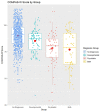Measuring mental wellbeing in clinical and non-clinical adolescents using the COMPAS-W Wellbeing Scale
- PMID: 38988735
- PMCID: PMC11234841
- DOI: 10.3389/fpsyt.2024.1333828
Measuring mental wellbeing in clinical and non-clinical adolescents using the COMPAS-W Wellbeing Scale
Abstract
Introduction: Adolescence is a key period of vulnerability for poor mental health as the brain is still developing and may be more sensitive to the negative impacts of stress and adversity. Unfortunately, few measures comprehensively assess wellbeing in adolescents.
Methods: The 26-item COMPAS-W Wellbeing Scale for adults was validated in a sample of 1,078 adolescents aged 13-17 years old (51.67% male, 79.13% non-clinical vs 20.87% psychiatric or developmental clinical cases). The six COMPAS-W sub-scales and total scale were examined in this sample using second-order confirmatory factor analysis, and psychometric testing.
Results: The 23-item COMPAS-W demonstrated the best fit for this sample according to goodness-of-fit indices (χ 2 (220, 1078) = 1439.395, p < 0.001, CFI = 0.893, TLI = 0.877, RMSEA = 0.070, SRMR = 0.095). Internal reliability for the confirmed 23-item COMPAS-W model was run for the total scale (α = 0.912) and sub-scales (Composure, α = 0.735; Own-worth, α = 0.601; Mastery, α = 0.757; Positivity, α = 0.721; Achievement, α = 0.827; and Satisfaction, α = 0.867). Test-retest reliability over 6 weeks was also good for the total scale at r = 0.845 and the sub-scales: Composure (r = 0.754), Own-worth (r = 0.743), Mastery (r = 0.715), Positivity (r = 0.750), Achievement (r = 0.750), and Satisfaction (r = 0.812). Compared with non-clinical participants' wellbeing (M = 90.375, SE = 0.400), those with clinical diagnoses reported lower wellbeing, both for those with developmental diagnoses (M = 85.088, SE = 1.188), or psychiatric diagnoses (M = 78.189, SE = 1.758), or combined developmental and psychiatric diagnoses (M = 77.079, SE = 2.116). Yet, when wellbeing category scores were considered by diagnosis group, both non-clinical and clinical groups demonstrated incidence across all three categories of languishing, moderate and flourishing wellbeing, in support of the dual-continua model of mental health. On average, younger adolescents' (13-14 years) wellbeing did not differ from older adolescents' (15-17 years) wellbeing; however, for sex, males scored 1.731 points significantly higher in wellbeing compared with females (p = 0.028); and American participants scored 3.042 points significantly higher in wellbeing compared with Australian participants (p < 0.001).
Discussion: In conclusion, the 23-item COMPAS-W is a reliable measure of wellbeing for adolescents, both for those with and without developmental and psychiatric diagnoses.
Keywords: adolescence; developmental disorders; mental health; psychiatric disorders; psychometric testing; reliability; validity; well-being.
Copyright © 2024 Lam, Park and Gatt.
Conflict of interest statement
The authors declare that the research was conducted in the absence of any commercial or financial relationships that could be construed as a potential conflict of interest.
Figures





References
-
- Bitsko RH. Mental health surveillance among children — United states, 2013–2019. In: Centers for Disease Control and Prevention, Atlanta GA, USA: Centers for Disease Control and Prevention (CDC) vol. 71. (2022). p. 1–42. Available at: https://www.cdc.gov/mmwr/volumes/71/su/su7102a1.htm.
-
- Leung S, Brennan N, Freeburn T, Waugh W, Christie R. Youth survey report 2022. In: Mission Australia Australia: Mission Australia; (2022).
-
- Keyes CLM. The subjective well-being of America’s youth: Toward a comprehensive assessment. Adolesc Fam Health. (2006) 4:3–11.
LinkOut - more resources
Full Text Sources
Miscellaneous

